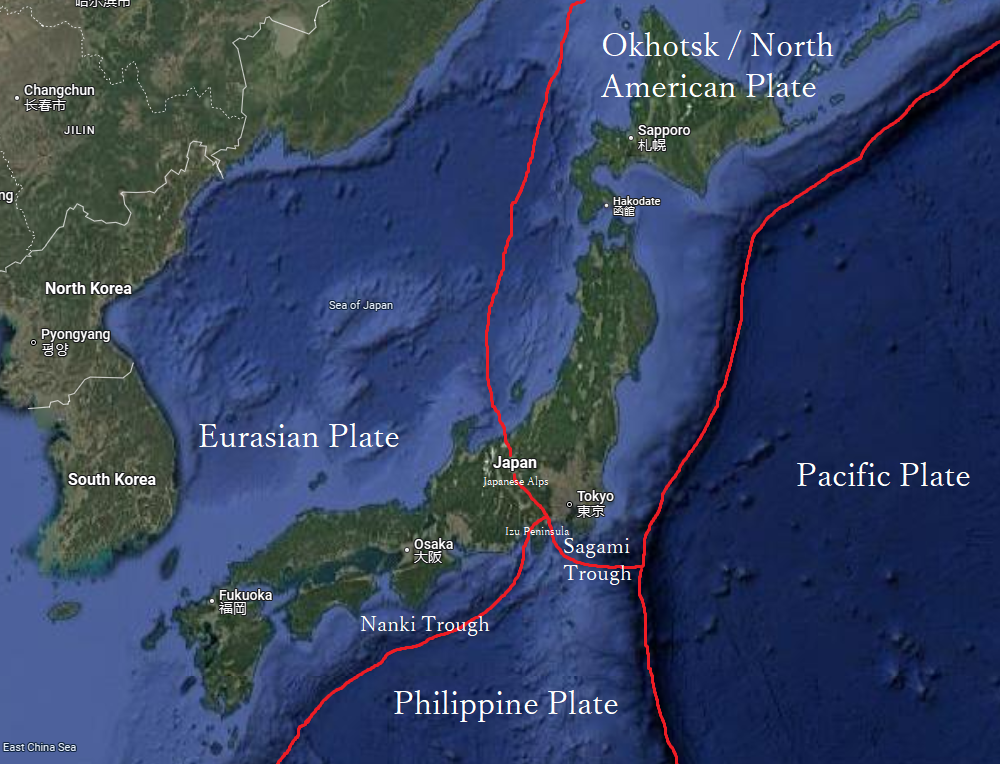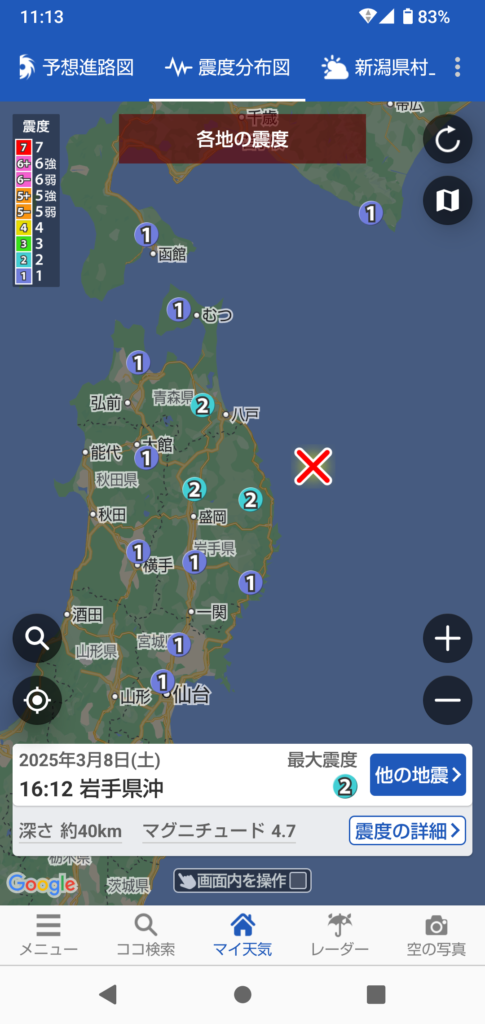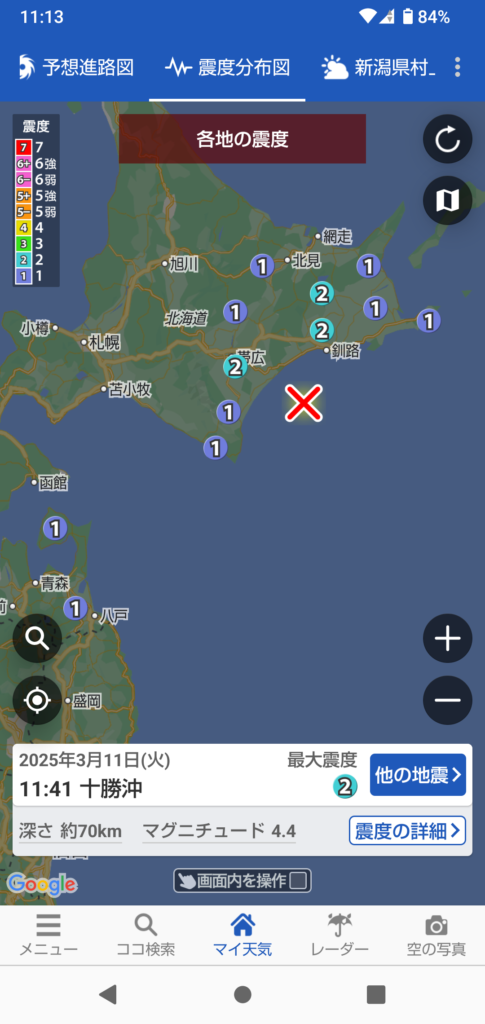
Earthquakes are among the most challenging phenomena to predict, even with today’s technology. Japan experiences daily seismic activity, making it one of the leading laboratories for earthquake research. Extensive studies are conducted to identify potential locations for future earthquakes.
Throughout the centuries, several massive earthquakes have consistently occurred in similar locations around Japan. Many of these larger earthquakes are recurring seismic events that take place along the tectonic plates. They tend to reoccur after specific periods—some after a few decades, others every 100 to 150 years, and some reoccur after a long period of time.
Why do earthquakes reoccur? Earthquakes are a result of tectonic plates exerting pressure on one another as they shift and move beneath the Earth’s surface. Over the years, this relentless movement gradually builds immense pressure along fault lines. Eventually, after a substantial period, the stress becomes too great for the rocks to withstand, leading to a sudden release of energy in the form of a powerful earthquake. This explosive release not only reshapes the landscape of Japan but also serves as a reminder of the dynamic nature of our planet. After the Earthquake the cycle restarts. Earthquake
北海道沖千島海溝/三陸地震 (Hokkaido Oki Chishima Kaikou / Sanriku Earthquake)
The Hokkaido Oki Chishima Kaikou is an area located near the island of Hokkaido. It extends along the boundary between the Pacific and North American tectonic plates, stretching from off the coast of Hokkaido to the southern Kuril Islands in Russia. The southern region of the Hokkaido Oki Chishima Kaikou also encompasses the Sanriku area along the East Coast of Aomori and the northern part of Iwate Prefectures in the Tohoku Region.
Throughout 2024 and into early 2025, there has been frequent seismic activity in the southern part of the Hokkaido-Oki Chishima Kaikou. Earthquakes have been particularly common off the east coast of Hokkaido, as well as in Aomori and Iwate Prefectures.
A recent study conducted by Tohoku University reveals significant strain on tectonic plates in this area, indicating the likelihood of a massive earthquake in the near future. The research estimates a 40% chance of such an earthquake, which could reach a magnitude of 9, occurring in the region over the next 30 years.
Here is an example of two recent Earthquakes in the region in the last few days:

On March 8th, 2025, an earthquake with a magnitude of 4.7 struck the San Riku area. The earthquake occurred at a depth of 40 kilometers below the Earth’s surface. Though not a large Earthquake, its impact area was significant, affecting a vast area that stretched from Hokkaido to Sendai in Miyagi Prefecture.

On March 11th, 2025, another earthquake occurred off the coast of Hokkaido. While it was not as strong as the earthquake on March 8th, it had a depth of 70 km. This earthquake was located along the Hokkaido Oki Chishima Kaikou and affected Hokkaido as well as the eastern coast of Aomori Prefecture.
Seismic activity has been frequent in this area. Based on the significant activity observed in 2024 and the increase in activity in 2025, I believe this region is more likely to experience a massive earthquake than the Nanki Trough area. However, with the exception of Southern Kyushu, the area surrounding the Nanki Trough has been relatively quiet in recent years. It’s important to remember that earthquakes are nearly impossible to predict, and the situation can change in an instant.
I often travel to Aomori for the Obon and New Year’s holidays because my wife is originally from the Shimokita Peninsula, which is located on the northeastern coast of Aomori Prefecture. Her family lives very close to the coast.
If you are a resident of Japan living in this area, it is crucial that you and your family take proactive steps to prepare for a major earthquake. Familiarize yourselves with the locations of nearby shelters and thoroughly understand your company’s emergency procedures in case of a significant seismic event.
For those visiting this area on holiday or just visiting, vigilance is essential. Stay alert to any signs of seismic activity and make it a priority to translate and comprehend emergency signs related to shelters or evacuation routes. Being well-prepared is not just important; it could be the difference between safety and danger in a crisis.
南紀トラフ地震 Nanki Trough Earthquake
The Nanki Trough is one of the most forecasted and anticipated earthquakes in Japan. It is situated between the Philippine and Eurasian Plates and extends over a large area off the coast of southern Japan, from Shizuoka Prefecture near the Izu Peninsula to the southern end of the island of Kyushu.
If an earthquake were to occur, it would impact the most densely populated areas of Japan. Earthquakes are highly unpredictable, and although the epicenter is forecasted to be off the coast of Shikoku, it could happen anywhere along the Nanki Trough. If it occurs off the coast of Shikoku, it will affect the entire island of Shikoku, as well as Wakayama and Hyogo Prefectures, including cities like Kobe, Himeji, and Awajishima. In addition, it will impact Okayama, Hiroshima, and Yamaguchi Prefectures. The island of Kyushu will also be affected, particularly in Miyazaki, Oita, and Kagoshima Prefectures.
If it were to occur on the eastern half of the Nanaki Trench, it would impact the entire southern part of the Kanto and Chubu regions, putting cities such as Shizuoka, Toyohashi, Nagoya, Yokohama, and Tokyo at risk from this earthquake.
If an earthquake were to occur in the central part of the Nanki Trough, it would put the entire Tokai region at risk. This region includes cities like Nagoya, Okazaki, Gifu, Yokkaichi, Tsu, and Ise, as well as areas in Wakayama and Shizuoka Prefectures.
On the other hand, if the earthquake were to take place off the coast of Wakayama Prefecture, it could impact the southern and, potentially, central Kansai Region. This would include cities such as Wakayama, Tanabe, Osaka, Nara, Awaji Island, Kobe, and areas in Kagawa and Kochi Prefectures. It might also affect Kyoto and Tsu.
Too Much Focus on the Nanki Trough Earthquake
Given the significant risks associated with a potential earthquake at the Nanki Trough, the Japanese government is proactively preparing for this event. While it is commendable to be prepared, it seems that the government is focusing solely on the Nanki Trough earthquake. This attention may be causing them to overlook other potential threats that could arise before the Nanki earthquake occurs, some of which could be even more severe.
Prior to March 11, 2011, there were predictions concerning the potential occurrence of the Tokai Earthquake.
When I first came to Japan, the Japanese government was focused on preparing for the potential Tokai Earthquake. However, on March 11, 2011, a massive 9.0 magnitude earthquake struck off the coast of Miyagi Prefecture, devastating the country. Prior to this event, there had been no predictions of a significant earthquake occurring in the Tohoku region, which took both the government and the entire nation by surprise. After the 9.0 earthquake, discussions about the Tokai Earthquake diminished, and attention shifted to a new forecast: the Nanki Trough Earthquake.
January 1st Noto Earthquake
A perfect example is the January 1st Noto Peninsula earthquake, which measured 7.6 magnitude. I experienced this earthquake while at home, just 19 km from the epicenter, and felt the full impact of it. The event shocked the entire country.
The Japanese government had been monitoring an earthquake swarm since December 2020 but failed to issue any warnings, predictions, or preparations to address this kind of disaster. Prior to December 31, 2023, the only explanation given for the earthquake swarm was that rising underground water was putting pressure on the surface, causing the tremors. Authorities claimed that this pressure would be relieved once the water reached the surface. However, there was no prediction of a future large earthquake that would devastate the region.
Experiencing the Noto Peninsula Earthquake firsthand has made me concerned about the current focus on preparing for the Nanki Earthquake. It seems like a lot of resources are being allocated to this, especially since the Tokai Earthquake has yet to occur. Meanwhile, other areas that have recently experienced frequent earthquakes, such as Chiba, Ibaraki, the Sanriku area of Aomori, Hokkaido Oki Chishima Kaikou, Wakayama, Nara, Mie, Kyoto, Northern Osaka, and Southern Kyushu, are being overlooked. Throughout 2024 and 2025, these regions have faced repeated seismic activity. Any of these locations could potentially be hit by an earthquake similar in magnitude to the one that impacted Kobe in 1995 and Noto in 2024, before the Nanki Earthquake occurs.
The Nanki Trough Earthquake Will Happen
The Nanki Trough Earthquake is expected to occur, but the exact location and timing remain unknown. If it is similar to the earthquake on March 11, 2011, we may observe signs in the weeks leading up to this significant event. In the days prior to the Nanki Earthquake, we can expect to see foreshocks throughout the southern part of Japan. This pattern was similar to what occurred before the March 11, 2011 earthquake.
IIf you live in Shikoku, near the coast of Kyushuu, or Wakayama Prefecture or anywhere around this region, it is important to prepare for the upcoming Nanaki Earthquake and check what measures your municipality is taking. Many towns in this region conduct earthquake drills, and it is beneficial to participate in these drills to understand what to expect when an earthquake occurs.
Be aware of the locations of evacuation shelters and have a tsunami escape route planned. This is especially crucial if you live along the coast near the Pacific Ocean on the southern coast of Japan: GET TO HIGH GROUND AS FAST AS YOU CAN! An earthquake can be severe, but a tsunami can be far worse than you might imagine.
Why its Essential to be Prepared

The image above illustrates the extent of the impact a massive earthquake can have. The epicenter was located off the coast of Miyagi, but the Earthquake was felt throughout Japan, from the northern tip of Hokkaido to the southern tip of Kyushu. If a similar event were to occur with the epicenter in the Nanki Trough, it could result in magnitude 5, 6, and 7 earthquakes affecting some of the most densely populated areas of Japan. It is a common misconception that magnitude 1 or 2 earthquakes are too minor to be felt. In reality, these subtle shaking can indeed be perceived, influenced by various factors such as the type of soil and rock beneath your feet, the depth at which the earthquake originates, and the length of time the shaking persists. These elements can amplify or diminish your experience of these slight seismic events, making them noticeable in certain conditions.
相模トラフ地震The Sagami Trough Earthquake
The Sagami Trough is situated near Mt. Fuji, where the Philippine, North American, and Eurasian plates converge. It extends through and off the coast of Kanagawa Prefecture and the southern Kanto region, reaching the Pacific Plate off the coast of Chiba.
In 1923, a cataclysmic earthquake struck the Kanto region, unleashing chaos and destruction upon Tokyo and leaving a trail of devastation across numerous cities. This region has a history of experiencing earthquakes with magnitudes of 8 or higher approximately every 200 to 400 years, creating a sense of vulnerability among the residence here. Although the likelihood of such a disaster occurring anytime soon is relatively low, recent patterns of seismic activity—evident both off the coast of Chiba Prefecture and inland near Mt. Fuji and the western parts of Kanagawa Prefecture—serve as a reminder that nature’s fury can awaken at any moment.
Regardless of where you live in Japan, it is essential to prepare for earthquakes. Always stay informed about the procedures your municipality has in place for earthquakes, know the location of your evacuation shelters, and ensure you have enough food and supplies in case such a disaster occurs.
You can prepare as much as possible for an earthquake, but there is no way to fully prepare yourself mentally for experiencing one and dealing with its devastating aftermath.
Leave a Reply